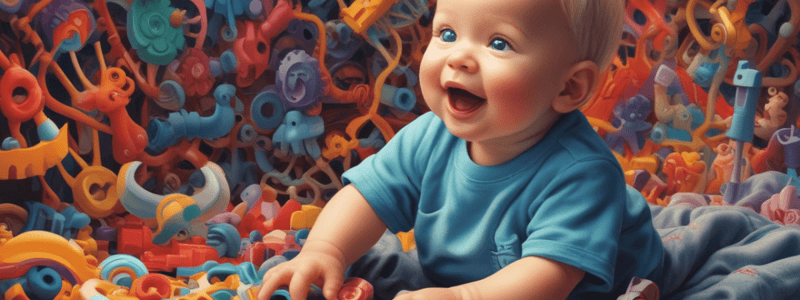Podcast
Questions and Answers
What is the main difference between gross motor skills and fine motor skills?
What is the main difference between gross motor skills and fine motor skills?
- Fine motor skills involve jumping and climbing, while gross motor skills involve manipulating objects.
- Gross motor skills involve larger muscle groups, while fine motor skills involve smaller muscle groups. (correct)
- Fine motor skills involve sitting with support, while gross motor skills involve using utensils.
- Gross motor skills include feeding self finger foods, while fine motor skills include walking.
Which milestone typically occurs earliest in an infant's development?
Which milestone typically occurs earliest in an infant's development?
- Sits with support (6 months)
- Lifts head while on their stomach (1 month) (correct)
- Rolls over both ways (3 months)
- Steps holding onto furniture (1 year)
What would be a key fine motor milestone for a 6-month-old infant?
What would be a key fine motor milestone for a 6-month-old infant?
- Grasping toy with fingers instead of palm (correct)
- Feeding self finger foods
- Using raking grasp to pick up small objects
- Turning pages one at a time
Which of the following is an example of fine motor skills?
Which of the following is an example of fine motor skills?
At what age would a child typically achieve the milestone of turning pages one at a time?
At what age would a child typically achieve the milestone of turning pages one at a time?
Which milestone involves the use of a raking grasp to pick up small objects?
Which milestone involves the use of a raking grasp to pick up small objects?
Study Notes
Motor Milestones: Understanding the Stages of Infant and Toddler Development
Understanding the stages of infant and toddler motor development is crucial for promoting healthy growth and early intervention when needed. Motor milestones, also known as developmental milestones, represent typical achievements most children reach within certain timeframes. They serve as guidelines for tracking a child's progress and identifying any possible delays or concerns.
Types of Motor Development
Motor skills are classified into two categories: gross motor and fine motor skills:
Gross Motor Skills
These skills involve larger muscle groups and movements, such as walking, running, jumping, and climbing. Some key examples of gross motor milestones include:
- By 1 month: Lifts head while on their stomach.
- By 3 months: Rolls over both ways.
- By 4 months: Crawls.
- By 6 months: Sits with support.
- By 1 year: Steps holding onto furniture.
Fine Motor Skills
These involve smaller muscle groups and movements related to manipulating objects, such as picking up small items, using utensils, and buttoning clothes. Key fine motor milestones include:
- By 2 months: Grasps toy with fingers instead of palm.
- By 6 months: Uses raking grasp to pick up small objects.
- By 1 year: Feeds self finger foods.
- By 18 months: Turns pages one at a time.
Remember, children develop at their own pace. If you observe any significant delays or concerns in your child's motor development, consult your healthcare provider for guidance and resources.
Studying That Suits You
Use AI to generate personalized quizzes and flashcards to suit your learning preferences.
Description
Learn about the stages of infant and toddler motor development, including gross motor skills like crawling and fine motor skills such as using utensils. Explore typical milestones and how they can help identify delays or concerns in children's growth.




